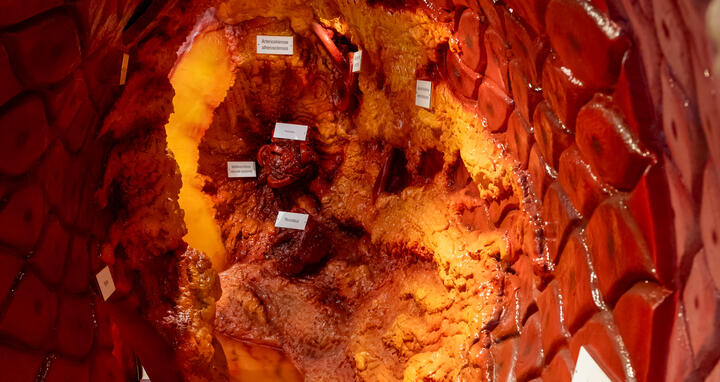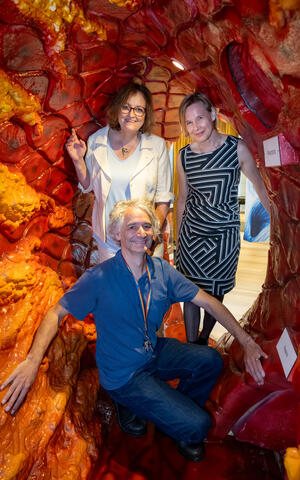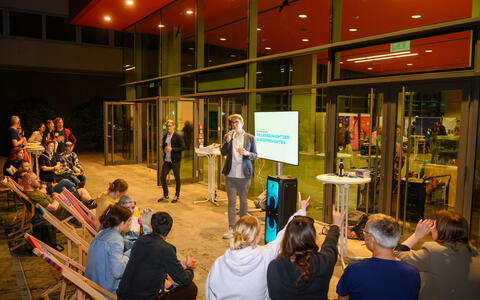Biomedical research, hands on
The countdown to the Long Night of the Sciences is on: On June 28, from 5:00 p.m. to 11:00 p.m., the Max Delbrück Center will open its labs and buildings at Campus Buch to guests of all ages. In celebration of the event’s 25-year anniversary, admission across Berlin will cost only €5. Children under six, as always, will be admitted for free. Some program highlights include:
Senator Ina Czyborra, Christina Quensel, Chair of the Long Night of the Sciences, and group leader Dominik Müller inside the walk-in artery at the Max Delbrück Center.
From blood vessels to the heart
Why don’t we yet fully understand our blood vessels? Why are they central to many diseases? And how do they find their way through the body? Visitors will have the opportunity to ask these questions and more during a walk-through tour of a 3D model of the most extensively studied vessel – an artery. The model will be located in the foyer of MDC.C (Building 83), and researchers will be available to explain and answer questions.
Directly across from the 3D model, experts in translating lab findings into applications in the clinic will be available to explain their work. They will demonstrate the types of measurements required for scientific studies. Guests can also explore how the heart works and what happens during a heart attack using VR headsets. The researchers will also present information about clinical studies related to pregnancy and cardiovascular diseases.
- Lab tour: When new blood vessels sprout (5:30 p.m., 7:30 p.m., and 9:30 p.m.; ages 12+, registration at the central info desk in MDC.C)
- 3D Model: The walk-in artery (5:00 – 11:00 p.m., foyer of MDC.C)
- Hands-on booth: “Translational Research – from Model to Human” (5:00–10:00 p.m., foyer of MDC.C)
Learning from mini-organs
Organoids are complex 3D models of human organs grown in the lab, usually from patient cells. They replicate features of organs and tissues in petri dishes. During the event, visitors can take part in interactive lab tours to learn about advances in this technology, how scientists at the Max Delbrück Center use robots to create organoids, and what questions to many uncurable diseases they can help answer.
- Lab Tour: Neuromuscular mini-organs (6:30 p.m., ages 16+, registration at the central info desk)
- Lab Tour: Decoding beta-cell biology to treat diabetes (6:30, 8:00, and 9:30 p.m.; ages 12+, registration at the central info desk)
- Lab Tour: How do developmental disorders of the heart and brain arise? (6:00 and 7:30 p.m.; ages 12+, registration at the central info desk)
Strange animals and why they’re fascinating for research
They feel little pain, are social and yet live in authoritarian hierarchical groups. They gossip and cuddle, grow very old, and navigate easily in complete darkness – naked mole-rats. During a lab tour, researchers explain how we can better treat human diseases by learning from them. During a reading of the book “Lebenskünstler” about bizarre animals, author Russ Hodge and publisher Wolfgang Hörner explain what naked mole-rats and 13 other species can reveal about ourselves.
- Lab Tour: “Naked mole-rats with a sense of tact” (9:30 p.m., registration at the central info desk)
- Reading with Russ Hodge, Galiani publisher Wolfgang Hörner + Q&A with researchers: “Remarkable” (5:30 and 7:30 p.m., Dendrite 2/3 in MDC.C)
Light show, portrait exhibition, and a pub quiz
Who are the people trying to understand our bodies in minute detail, who develop therapies for the benefit of all? In the portrait exhibition “Discoverers,” researchers from the Max Delbrück Center will be showcased in photographs by Pablo Castagnola.
At sunset, “Cellular Echo” will project microscopic images of cells onto the exterior wall of a building, transforming them into a light and sound installation — a hymn to the diversity and beauty of life’s building blocks. And for those who enjoy nerdy science trivia, the pub quiz will be just their thing.
- Exhibition: “Discoverers” (5:00 – 10:00 p.m., foyer in Building 84)
- Pub quiz: “From ECGs to 80s hits” (from 9:00 p.m., terrace behind MDC.C)
- Light show: Cellular Echo (from 10:00 p.m. in front of the Erwin Negelein Building)
Further information
Images for download
“How stress changes behavior” is what guests will learn about during one presentation while relaxing in a deck chair on the terrace of the MDC.C at Café Scientifique. Photo credit: Matthias Lindner, Max Delbrück Center
Beta cells in a petri dish help researchers better understand diabetes. Photo credit: Sander lab, Max Delbrück Center
Contact
Jutta Kramm
Head of Communications
Max Delbrück Center
+49 30 9406 2140
jutta.kramm@mdc-berlin.de or presse@mdc-berlin.de
- Max Delbrück Center
-
The Max Delbrück Center for Molecular Medicine in the Helmholtz Association aims to transform tomorrow’s medicine through our discoveries of today. At locations in Berlin-Buch, Berlin-Mitte, Heidelberg and Mannheim, our researchers harness interdisciplinary collaboration to decipher the complexities of disease at the systems level – from molecules and cells to organs and the entire organism. Through academic, clinical, and industry partnerships, as well as global networks, we strive to translate biological discoveries into applications that enable the early detection of deviations from health, personalize treatment, and ultimately prevent disease. First founded in 1992, the Max Delbrück Center today inspires and nurtures a diverse talent pool of 1,800 people from over 70 countries. We are 90 percent funded by the German federal government and 10 percent by the state of Berlin.








